Hodi Mihi Cras Tibi - TRIS collective grave
In various places in Paramaribo, you will find references to fallen soldiers of the Armed Forces in Suriname, or in Dutch “Troepenmacht in Suriname”, TRIS for short. More than forty names are commemorated at a historic location at Fort Zeelandia in Paramaribo. A collective grave of 14 men can be found at the Hodi Mihi Cras Tibi cemetery on the Sophie Redmondstraat in Paramaribo. And then there are several graves in other cemeteries in Suriname, but also a number in the Netherlands. A search for their graves and funerary monuments seems almost impossible, but this article aims to gain an insight.
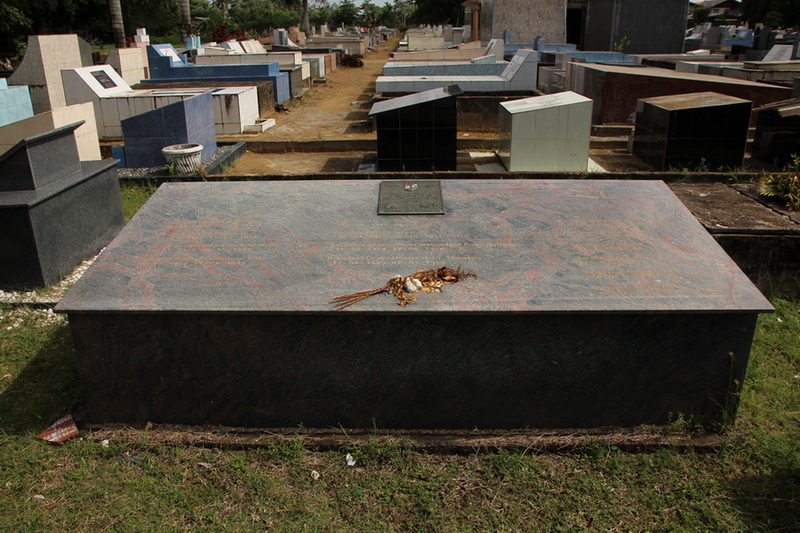
Military in Suriname
Ever since the first conquest of Suriname by Abraham Crijnssen, the security of the colony was entrusted to the military. From various forts, such as Zeelandia and Sommelsdijck, the soldiers oversaw the protection of the plantations and their inhabitants. Those forts were there for a reason, because the Republic was regularly involved in wars that were also fought along the so-called Wild Coast in South America. Attacks from foreign powers were met with more forts, such as Fort New Amsterdam. After the external threat subsided, the military increasingly focused on suppressing domestic insurgents. Raids on plantations by escaped enslaved people were first fought by civilian patrols and later by the troops. A so-called cordon path with armed posts was supposed to provide security, but in the end the costs did not outweigh the merits. After an English takeover during the French period, the new Kingdom of the Netherlands established a strong force in Suriname after 1816. However, due to the economic downturn, little was invested in this force. Moreover, after the abolition of slavery, the nature of the force changed. Coercion was no longer a legitimate means, and a police force was needed for that. Because many former soldiers joined the police force, it took on a military character.
At the end of the nineteenth century, the force was mainly used to settle conflicts with workers on the plantations. Those workers fought for better working conditions, which was seen as a revolt at the time. Military force was often used to put an end to such uprisings, often at the cost of many deaths. From 1908 onwards, the Royal Netherlands East Indies Army (in Dutch KNIL) was charged with the defense of Suriname. Of the forces based here, the officer corps was European, while the same was true of half of the men. The rest consisted mainly of Surinamese people of Creole descent. At that time, the KNIL was not expected to play a role in the defense of the country. This was left to the Dutch Royal Navy, but they hardly paid attention to Suriname.
Stagnation and reconstruction of the military presence
Until the outbreak of the Second World War, the strength of the force had been steadily reduced. In the end, the strength was still about 200 men. In the meantime, the mobilization of a civilian militia was no longer possible after it was abolished in 1926. The force was now mainly concerned with police tasks such as patrols against poachers, guarding government buildings, the first mines in Suriname, prisoners and the borders. Reinforcements requested for the impending conflict that would become the Second World War were not taken seriously by the Netherlands. However, Governor Kielstra did take measures and reintroduced the militia, which was trained in a short time and was able to supplement the troops.
After the occupation of the Netherlands in May 1940, the attention of the government-in-exile did not immediately turn to Suriname. The Dutch East Indies had a higher priority. However, on 10 May, Kielstra ordered all Germans to be interned in Surinam on orders from the Netherlands. The Goslar, a German ship that was moored on the Suriname River, was sunk by the captain. The crew was interned. The wreck of the ship is still there.
It was thanks to the United States, which had a great interest in the extraction of bauxite, that from 1941 onwards the force in Suriname grew again. After the fall of the Dutch East Indies, Suriname could even serve as a springboard for the Dutch government to reconquer that colony. The U.S. had already built fortifications in the region, and the importance of bauxite mining in Suriname was essential to the American war industry. After the attack on Pearl Harbor in December 1941, the plans of the Americans gained momentum. The small airfield Zanderij was transformed into a real air force base and the number of American troops grew to more than 2,000 men. Subsequently, it was the Dutch government that sent more troops to Suriname to prevent Suriname from being taken over by the Americans. By the end of 1941, the Dutch force had grown to about 500 men. Among them were about 160 men from the Princess Irene Brigade, which was founded in January 1941. In the course of the war, that number would grow even further and as the war continued, hundreds of soldiers left for training elsewhere and to be deployed in the liberation of Europe or the Dutch East Indies.
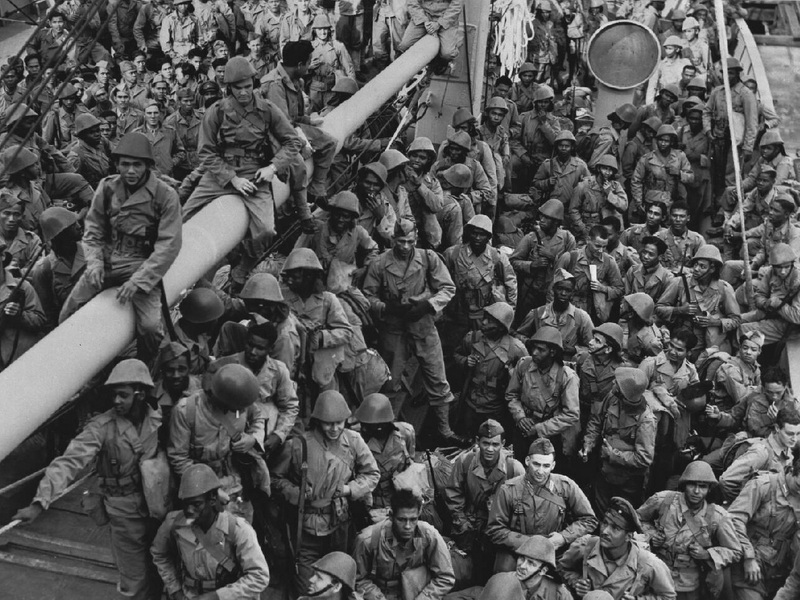 Soldiers arrive from Suriname in Australia, 1944-1945 (photo Anefo)
Soldiers arrive from Suriname in Australia, 1944-1945 (photo Anefo)
As early as 1944, investments in the defense of Suriname declined after the Allied campaign in Africa and Europe went well. Many men were transferred to England to be able to fight against the Germans and later against the Japanese, and they were subsequently deployed in the military actions during the liberation struggle of the Indonesians. The end of this also had far-reaching consequences for the troops in Suriname.
After the departure of most of the troops to Europe, about 100 to 150 KNIL soldiers remained in Suriname. The situation almost reverted to a pre-war situation. After that, another troop build-up took place, which in 1947 gave the KNIL more than 500 men at its disposal in Suriname. The force remained at full strength due to domestic tensions and a growing call for independence for Suriname.
End of KNIL, start of Forces in Suriname
After the disbandment of the colonial army in July 1950, the future of the Suriname Army was uncertain. It was decided that Dutch and Surinamese professional soldiers of the KNIL would join the Royal Netherlands Army. Other servicemen were offered provisional service. However, as part of the Royal Netherlands Army, no conscripts could be sent to Suriname. This was solved by having the task of the Army in Suriname carried out by the Marine Corps. After all, they could serve anywhere in the world, including the conscripts. Although about 150 marines served in Suriname in the period up to 1953, this was not the solution. This was found in the assignment to the Royal Netherlands Army to take on the task of defending Suriname. The force would also have to be considerably expanded with conscripts. In the meantime, the Korean War was raging, for which about a hundred Surinamese soldiers were deployed.
In 1954 Suriname became an independent country within the Kingdom and in 1957 the Army in Suriname was officially given a new name: the Troops in Suriname, abbreviated as TRIS. In an increasingly autonomous Suriname, the TRIS operated as an affirmation of old values. Although the TRIS was more subservient to the population, it remained a stronghold of the Dutch and its size grew to almost 1,000 men. It was not until 1963 that Surinamese men were also given the opportunity to follow an education in the army. In the same year it was announced that a modern military hospital would be built in Paramaribo and that the armed forces would receive more modern weapons.
The then commander of the TRIS, Colonel Beets, had submitted a request to the governor of Suriname on 31 December 1959 for the construction of a military cemetery. It should be located at the new cemetery to be built near the “Zorg en Hoop” airport in Paramaribo. The commander had noticed that the soldiers who had died up to that point had been buried in various cemeteries. A more central location would show more piety towards the next of kin and would also facilitate maintenance. The request was approved in September 1960 with the announcement that part of the new cemetery would be set up as a separate military cemetery with a separate entrance. The cemetery that was talked about was laid out, but a military part was never realized.
The deployment of the TRIS
The thousands of young Dutch men who served in Suriname from 1957 onwards were selected in the Netherlands during the basic training. The assignment to Suriname took place after a 4-month advanced training and lasted one year. The officer corps continued to consist of professional soldiers, many of whom still came from the KNIL.
Between 1945 and 1975, the year of Suriname's independence, 44 soldiers lost their lives. These were mostly not combat related, but due to accidents and illnesses, many of which were not even service-related. There were clashes in border conflicts, but there were never any fatalities. However, 2 soldiers later died as a result of injuries sustained.
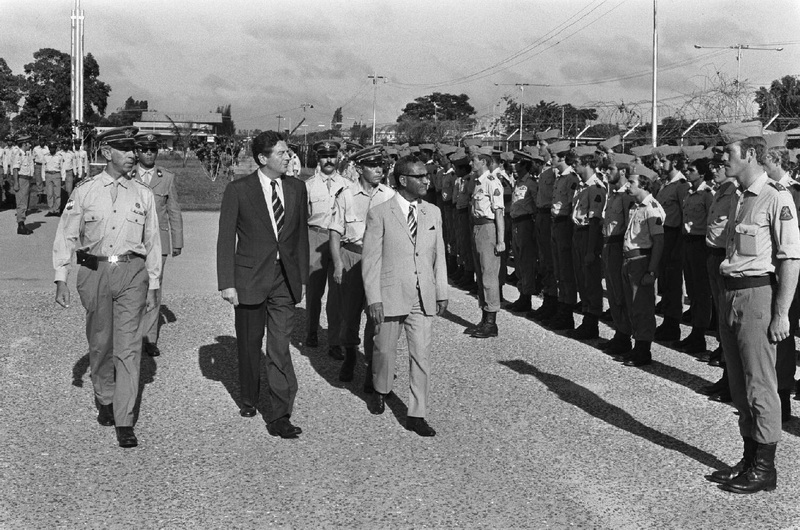 Last roll call TRIS, Ferrier and State Secretary Van Leut inspect guard of honour (Anefo Collection)
Last roll call TRIS, Ferrier and State Secretary Van Leut inspect guard of honour (Anefo Collection)
The TRIS Monument at Hodi Mihi Cras Tibi
When it became clear in 2009 that the graves of 14 soldiers at Nieuw Lina's Rust and the Catholic cemetery, both in Paramaribo, would be cleared, the interest group of the veterans, the TRIS foundation contacted the Ministry of Defence in the Netherlands. They cooperated in the relocation of the remains to a collective grave at the Hodi Mihi Cras Tibi cemetery. Here, in a solemn ceremony on November 9, 2010, the new tomb was dedicated. The ceremony was attended by about 30 veterans and relatives. The management of the tomb, made of red-black granite, is the responsibility of the TRIS foundation. Every year, the Ministry of Defence and TRIS place a wreath at the tomb and the memorial monument which later on was erected at Fort Zeelandia.
The 14 soldiers at Hodi Mihi Cras Tibi died between 1936 and 1969. The very first was Sergeant Major Gillich. He died of an illness. It is not known what caused the death of a number of them. This is not the case with Corporal Reiters, who was hit on the head by a branch during an exercise on the Saramacca River in October 1951. He died of the fracture of the base of his skull. Reiters was active in the Dutch East Indies during the Second World War and became a prisoner of war there. He was held in a camp in Burma. After the war he served during the Dutch actions against the Indonesian freedom fighters and was send from there to Suriname. Reiters was buried with military honors at the Catholic cemetery in Paramaribo.
The date 25 February 1955 is mentioned with the names of 6 soldiers, namely 3 soldiers, 2 sergeants and 1 first lieutenant. During an exercise near Matta, about 65 kilometers south of Paramaribo, a landmine exploded, killing 6 soldiers and wounding 8. The dead were first lieutenant Blijstra, sergeants Nijland and Van den Born and privates Van der Aa, Westra and Killian, all unmarried. Blijstra, Nijland, Van den Born and Westra were buried at Nieuw Lina's Rust and Van der Aa and Killian at the Catholic cemetery. The funerals took place in the presence of the governor of Suriname and several other authorities.
The last deceased and mentioned soldier is the adjutant non-commissioned officer Harry Tilmanns. It is not known what or how he died.
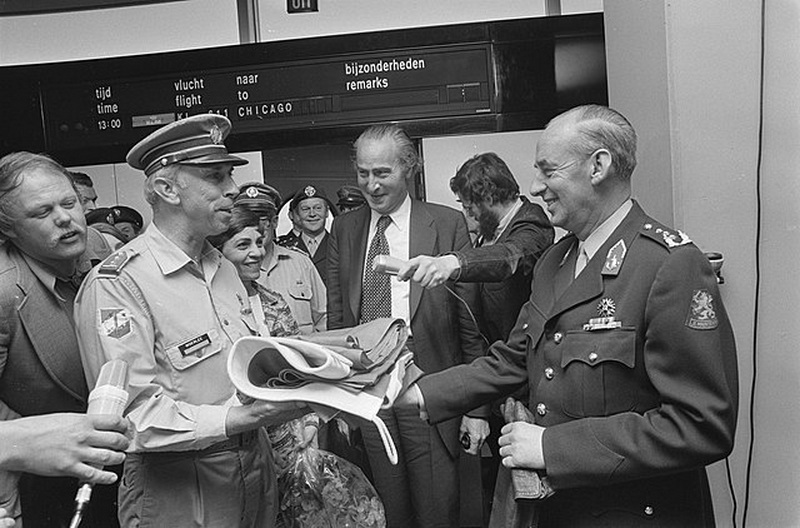 The last Dutch soldiers from Suriname arrive at Schiphol with their commander (picture Nationaal Archief)
The last Dutch soldiers from Suriname arrive at Schiphol with their commander (picture Nationaal Archief)
Memorial Fort Zeelandia
There are several memorials on the grounds of Fort Zeelandia, including one for the fallen soldiers of the TRIS. The monument bears the names of 46 soldiers who died, the last of them in 2003. The names are listed by period.
The monument consists of two truncated obelisks on a common base, all made of grey granite. The whole stands on a concrete base that is bordered with low black posts with chains in between. That part is in a larger frame with gravel that is fenced off with concrete tires. The obelisk on the right is the lowest and a statue of a soldier in TRIS uniform is included on the front. In his right hand the figure holds a Lee Enfield rifle, which has been used by the military in Suriname for a long time. On the right side of this obelisk is the inscription "TRIS-Monument" with a small brass text plate underneath stating that the unveiling took place on 15 November 2013 and was performed by Mr. M. Lamuré C.A. Latour, Minister of Defense of Suriname, together with retired General Peter J.M. van Uhm, former Commander of the Dutch Armed Forces. Although 15 November is listed here, the actual unveiling took place on 27 November. This is also mentioned on a separate plaque on the left side of the monument. The obelisk on the left is the taller of the two and is surmounted by a bronze effigy of a TRIS soldier in the field with a pack and the inseparable 'hack' or machete. At its base is depicted a small caiman and cut leaves. On the front is the coat of arms of the TRIS depicted with a sword in the middle with a circle with 5 stars around it. Underneath is a plaque with the unveiling date of 15 November 2013, the coat of arms and the text (here in translation): "FOR THOSE WHO FELL AWAY FROM US AND THOSE WHO STAYED 1945-1975". At the bottom of the plaque on the left is the emblem of the Infantry Regiment Oranje Gelderland and on the right the coat of arms of Suriname. Within the Army, the TRIS was an organic part of the Infantry Regiment Oranje Gelderland.
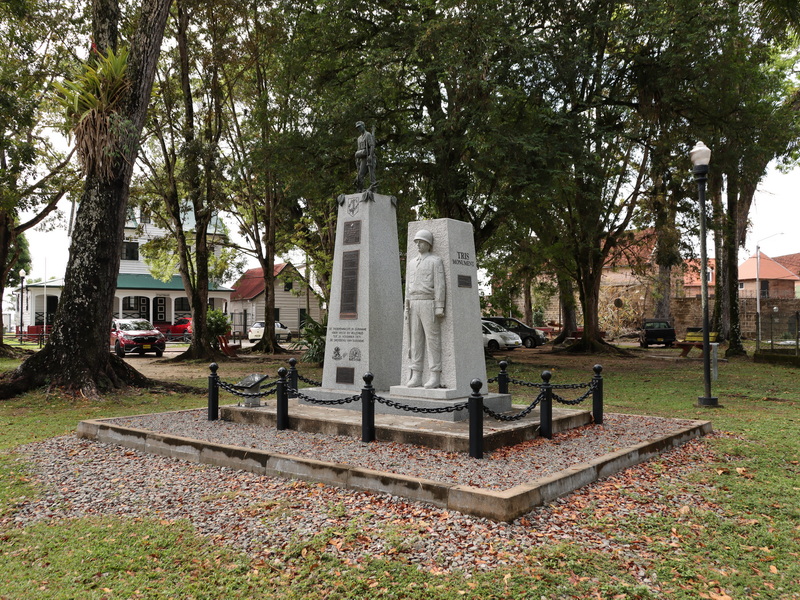 The TRIS monument at Fort Zeelandia in 2023.
The TRIS monument at Fort Zeelandia in 2023.
Below this plaque is an elongated plaque with the names of all fallen soldiers. Including the later deceased soldiers Schipper and Gloudemans, there are 44, but at the bottom a small plaque has been added with 2 names, namely corporal De Back and soldier Van der Zee. Below the plaques is the following text "THE FORCE IN SURINAME FOR PEACE AND SECURITY UNTIL 25 NOVEMBER 1975: THE SREFIDENSI OF SURINAME. Underneath is the coat of arms of the Dutch Army and the coat of arms of Suriname with a wreath.
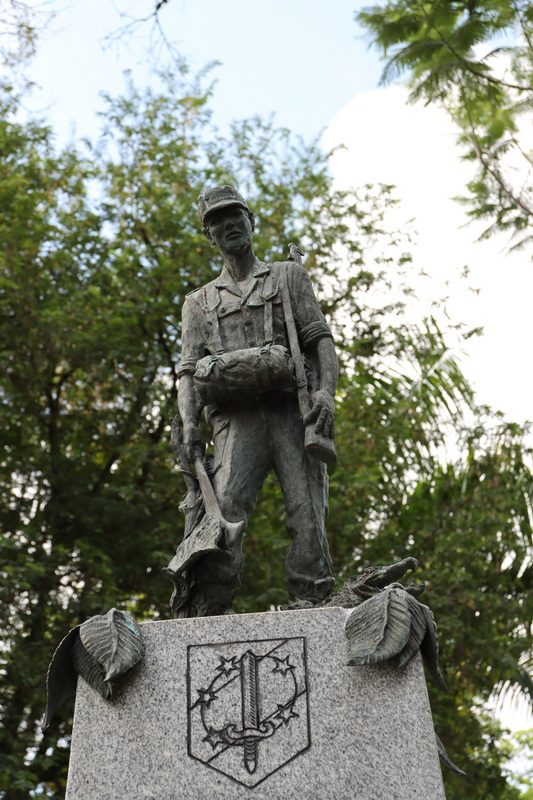 Detail of the TRIS-monument at Fort Zeelandia.
Detail of the TRIS-monument at Fort Zeelandia.
Finally, underneath is a small plaque with the justification for the placement of the monument and who made it possible. The monument was made by the Dutch sculptor Lia Krol and her husband artist Jaap Paasman.
A similar monument can be found in the Netherlands. Earlier, in 2007, a monument was unveiled in Ermelo at the General Spoor Barracks with the same bronze statue of a soldier with a caiman. Just like in Suriname, the erection of this 'TRIS monument' was an initiative of Ad van Wingerden, Jan Felet and Ton Verzendaal, all three former Trissers. The monument was created with the support of the Ministry of Defence and former Trissers. At the unveiling on 22 September 2007, Johan Ferrier, the last governor of Suriname and first president of the independent republic, and retired general Woerlee, the last Dutch commander present in Suriname, while commander of the Armed Forces general Peter J.M. van Uhm laid a wreath at the monument. The Infantry Regiment Oranje Gelderland itself commemorates 47 soldiers who died during the deployment of the regiment as part of the Armed Forces in Suriname (TRIS) between 1945 and 1975 at the Johannes Post barracks in Havelte.
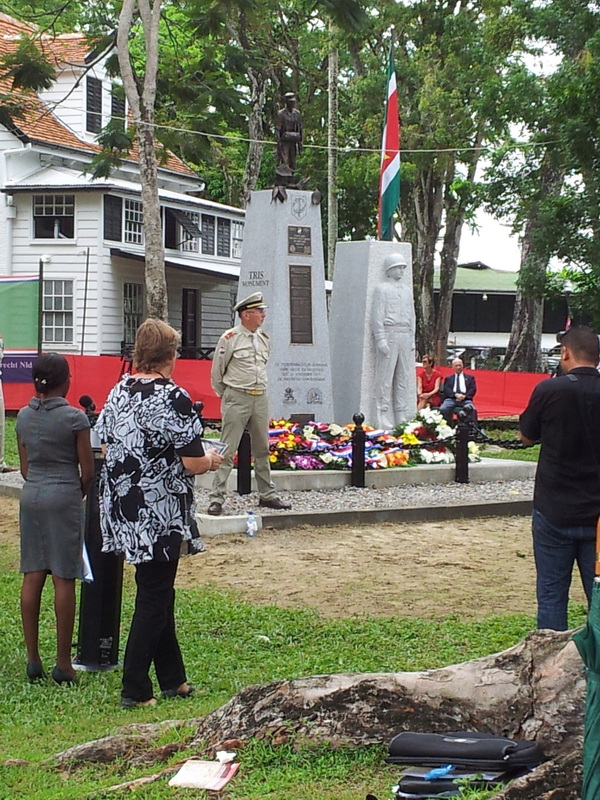 Unveiling of the monument for the TRIS (photo Ronald Huizer).
Unveiling of the monument for the TRIS (photo Ronald Huizer).
A striking detail, however, is that the monument in Paramaribo may have been placed on the grounds of a real military cemetery. Stephen Fokké researched the lost cemeteries of Fort Zeelandia and knows with a probability bordering on certainty that the TRIS monument was placed on the "military cemetery" of the outer fort at Fort Zeelandia. Archival research showed that between 1667 and 1799 more than 400 people were buried here: governors and spouses, commanders and other senior officers and their relatives, ship captains, members of the judiciary, pharmacists and other prominent figures in the former colony. However, there is nothing that reminds us of this cemetery anymore.
Names on the monument
The monument contains, among other things, the names of the soldiers who were involved in the traffic accident in August 1970 in which three of them died. The truck in which the soldiers were travelling collided with an asphalt truck on its way to Zanderij airport. First lieutenant Van Ravenhorst and soldiers Lassche and Valk were killed. Private 1st class Schipper was seriously wounded. He is also mentioned on the monument, as one of the deceased from 2003. The last person mentioned on the monument, soldier Gloudemans, was probably also involved. He also died in 2003.
It is known what caused the death of 60% of the soldiers. A distinction can be made between direct service-related accidents, non-service-related accidents and others. The service-related accidents occurred during exercises, bivouacs or transport trips. The landmine accident in 1955 immediately snatched away 6 soldiers and is the largest accident that happened to the TRIS between 1945 and 1975. Furthermore, there were accidents with jeeps and trucks involved in traffic accidents. Occasionally, a grenade went off too early and several soldiers were injured or killed. There were also some cases of drowning, as well as illness. It is not known which diseases these were. Most soldiers were killed in the 1970s, as many as 16. But there were also some soldiers who became unwell during the service and died afterwards. And in one case, it's about a sergeant who was electrocuted at home while doing odd jobs.
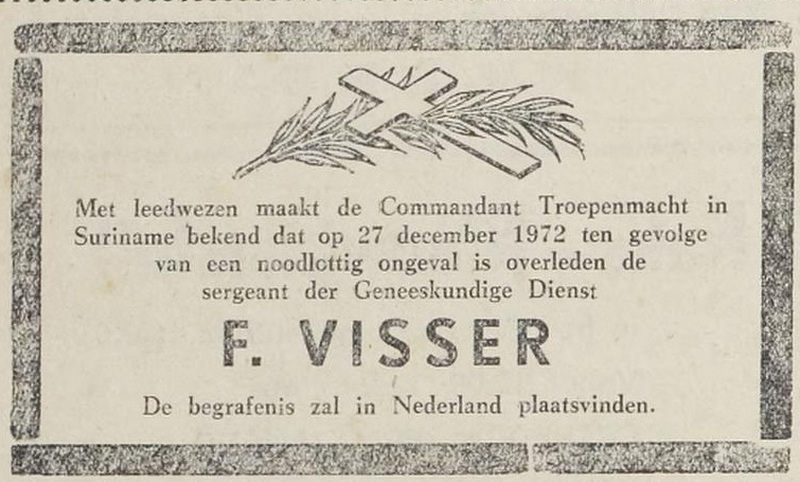 Announcement of the death of sergeant F. Visser in the Vrije Stem 30-12-1972
Announcement of the death of sergeant F. Visser in the Vrije Stem 30-12-1972
The average age of the deceased was 32, the youngest was 19 and the oldest 54.
The Surinamese Armed Forces
After independence on 25 November 1975, the Armed Forces of Suriname took over the equipment and infrastructure of the TRIS. Surinamese officers who previously served in the TRIS transferred to the armed forces and many Surinamese soldiers who served in the Royal Netherlands Army transferred to the new armed forces. In 1980, a group of 16 sergeants staged a coup and the army took over the rule in Suriname. The ties with the Dutch army were severed. The Surinamese Armed Forces was renamed the National Army. After the restoration of democracy in Suriname, the country has been working on a small, battle-ready army that once more is working together with the Dutch army.
With thanks to René ten Dam and Stephen Fokké.
Literature:
- Klinkers, Ellen; De troepenmacht in Suriname. De Nederlandse defensie in een veranderende koloniale wereld 1940-1975, Den Haag 2015
- Fokké, Stephen; Het mysterie rond de verdwenen begraafplaatsen van Fort Zeelandia: voorlopige onderzoeksresultaten, in: Tijdschrift voor Surinamistiek en het Caraïbisch gebied, 2016
Internet:
- De Troepenmacht in Suriname Online: https://www.trisonline.nl/
- Nationaal Comité 4 en 5 mei: https://www.4en5mei.nl/oorlogsmonumenten/zoeken/4390/paramaribo-tris-monument-1945-1975
- 10.26 Inventaris van het digitaal duplicaat van het archief van de Gouverneur van Suriname: Kabinet, (1934) 1951-1975 (1982) inv. nr. 1793: Stukken betreffende een voorstel van de commandant van de troepenmacht in Suriname om bij het vliegveld Zorg en Hoop een militaire begraafplaats aan te leggen. https://www.nationaalarchief.nl/onderzoeken/archief/2.10.26/invnr/1793/file/NL-HaNA_2.10.26_1793_0001
- Oorlogsgravenstichting: TRIS monument in Ermelo: https://oorlogsgravenstichting.nl/monumenten/ermelo-tris-monument
- Several newsitems, articles en obituaries: https://www. delpher.nl
- Last updated on .


